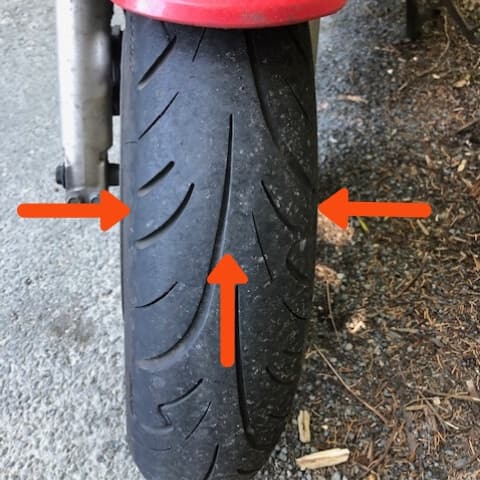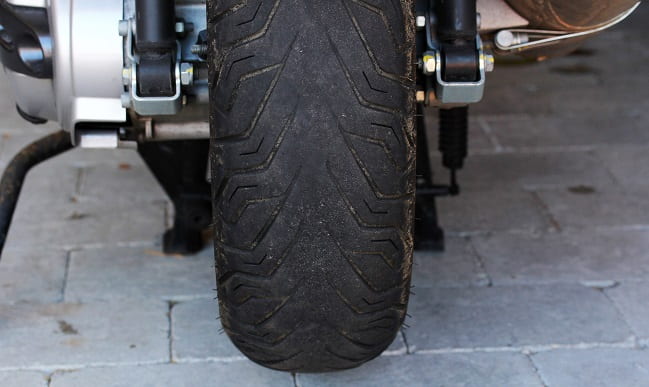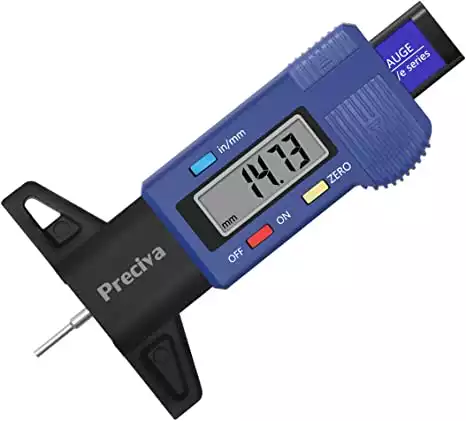Having enough tread on your tyres will keep you safe and on the right side of the law.
It’s easy to check at home with or without dedicated tools, so let’s look at what you need to know.
Save Money On Your Motorcycle Insurance
- You could pay less than £195*
- Compare quotes from 25+ UK providers
- Fill in one form to compare top bike insurers
What Is Tread Depth?
Tread depth is a vertical measurement from the top of a tyre’s tread rubber to the bottom of its deepest grooves.
Thread grooves give tyres their grip in wet conditions; their depth is how we monitor how much life is left in a tyre.
Once under a certain amount of tread left, the tyre is unsafe (and illegal) to ride on.
Where Do I Measure Tread Depth?

Depth measurements should be taken from various grooves in different places across the tyre’s surface.
Road riding tends to wear out tyres in the middle first, with the grooves closer to the tyre wall often remaining nearly untouched.
Make sure you check the grooves down the centre line of the wheel.
Remember: the lowest depth you find is the accurate indicator of how much life your tyres have left.
How do I Measure Tread Depth?
Some manufacturers include tread depth indicators in their design.
These are raised areas inside the tyre groove.
When the wear gets close to these raised areas being level with the tread rubber, it’s time to change your tyres.
Other options for taking measurements range from digital measuring tools right down to using a 20p piece.
The 20p piece is an old favourite of UK riders.
Insert a 20p piece into the groove and take a side view.
If the depth of the groove covers the outer band of the coin, your tyres are good.
If not, it’s time to change them.
Tools
These methods are far from definitive, and a range of inexpensive digital and analogue tread-depth measurement tools are available online.
They generally work by placing the tool flat on the tyre and then dropping a pin into the groove.
The tread depth will then be displayed in mm on a digital or analogue display.
This one (pictured below) is well-reviewed and very cheap.
What’s The Legal Requirement?

UK law demands a minimum tread depth of 1mm across ¾ of the tread pattern with visible tread on the remaining ¼ for bikes over 50cc.
Under 50cc requires all the grooves of the original tread pattern to be visible – if any grooves have worn smooth, your tyre needs changing.
Motorcycle MOT
Worn tyres will result in an immediate fail on your motorcycle MOT. Enough said!
What Causes Tyre Wear?
Ideally, tyres wear reasonably evenly across their entire surface.
In practice, this is often not the case.
The riding most commuters and casual riders do means that the treads closer to the tyre wall will wear out more slowly than those in the centre.
This is because we rarely lean into our turns knee-down with the edge treads in direct contact with the road.
Tyre Pressure
Overinflation and underinflation are the primary causes of unnecessary, uneven tyre wear.
These will often manifest in a ‘squaring off’ off the top of the tyre and can cause handling problems – buy a gauge and check your tyre pressure often.
Suspension
‘Scalping’ is where indents and pits form on the front tire and is usually caused by problems with the suspension.
Riding Style
Overloading your bike will also cause premature tyre wear, particularly if the weight is unevenly distributed.
Different riding surfaces significantly affect tyre wear. Riding on gravel can increase wear dramatically.
If you notice uneven wear on your tyres, point it out to your mechanic.
Age
Something worth mentioning is that tyres should be used within five years of their manufacture date.
This is because oils in the rubber can dry out and deteriorate over time, reducing their grip.
A tyre might look brand new but not be road worthy due to age.
Every tyre has its manufacture date stamped on the tyre wall.
Conclusion
It’s essential to get this one right for safety and to stay on the right side of the law.
Once you’ve been riding a few years, you’ll know how long to expect from a tyre with your riding schedule.
Keep an eye on your tyres, consider investing in an inexpensive tread depth tool, and mention any uneven wear to your mechanic as soon as you notice it.

